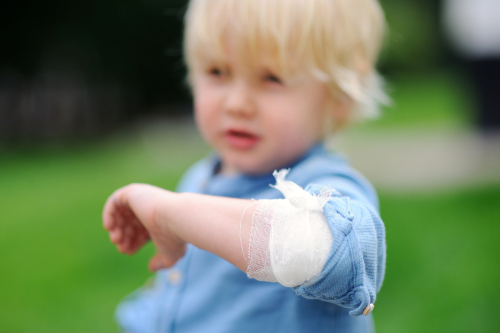Topical Anesthetic May Ease Pain of Dressing Changes With Severe EB, Trial Suggests

Topical ropivacaine, a local anesthetic marketed as Naropin, eased the pain associated with wound care in children with severe epidermolysis bullosa (EB) in a small clinical trial.
The study, “Efficacy of topical ropivacaine in children and young adults with hereditary Epidermolysis Bullosa,” was published in the British Journal of Dermatology.
Treatment for EB generally focuses on preventing blisters and managing wounds. Regular dressing changes help to protect against skin loss and infection, but often cause pain and discomfort.
Although changing dressings in a bath or with wet compresses is helpful, it does not get rid of pain completely. These children can develop anxiety and even phobia of baths.
Opioids to prevent pain and hypnotics to control anxiety are standard treatments before baths. Their effectiveness varies, however, and they often cause side effects.
Researchers from the Necker-Enfants Malades Hospital, in Paris, tested whether the topical anesthetic ropivacaine could ease pain during dressing changes.
They recruited 10 pediatric patients (five boys and five girls, median age 10.3), all of whom needed hospitalization to manage their severe EB. Participants rated their pain intensity during dressing changes as at least a four out of 10 on the visual analog scale or the Face Legs Activity Cry Consolability.
One child had epidermolysis bullosa simplex, while the other nine had recessive dystrophic EB.
The trial (NCT03730584) primarily sought to lower pain scores by at least two points when entering the bath on day five, as compared to baseline, or day one (study start). A similar difference during dressing change on day five provided a secondary measure of success.
The first three baths took place at the hospital’s dermatology unit, after which patients continued to use ropivacaine during baths at home for another 15 days.
Patients followed their usual procedure for their first day’s bath. In the next two baths, taken on days three and five, they were given topical ropivacaine (not more than 1 mg/kg) on wounds identified (mostly two-to-four limb wounds) as most painful, 15 minutes before entering the water. Those with unusual pain during dressing removal were given ropivacaine via small lateral lifting of the dressing before its complete removal in the bath.
Pain scores dropped upon entering the bath by a mean of 3.7 points by day five. Eight children recorded reductions of at least two points.
Pain associated with dressing changes dropped by a mean of 3.1 points on day five. Again, eight children reported an easing of at least two points, while two others reported moderately increased pain.
Seven children (or their parents) reported that ropivacaine continued to reduce the pain of bathing and dressing changes during home use. Two others reported pain relief only when entering the bath during this time, and one child reported never feeling relief with ropivacaine’s use.
No adverse side effects were reported during the study. The nine patients who underwent a blood test after a topical application showed far lower levels of the treatment than the maximum tolerated.
Despite the small number of patients and short follow-up period, “these results suggest that topical ropivacaine could be efficient to reduce wound care induced pain for patients with EB,” the investigators wrote.
Long-term safety and pharmacological studies are needed before recommending routine clinical use, they added.






